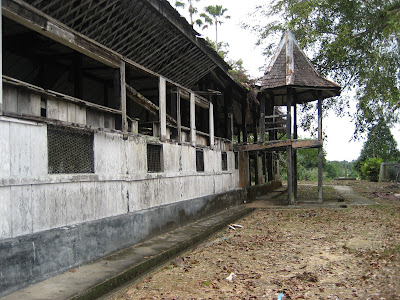FORT ALICE, many many years ago
FORT ALICE, present day
Oh ha! Oh ha...
Pukul lapan udah munyi...
Tangga undah tarit
Pintu udah tambit
Orang kampong enda tau niki agi...i...
Oh ha! Oh ha...
It was 8 o'clock at night and the yelling came from Fort Alice. The corporal of the guard, having made sure all doors locked, pulled up the drawbridge which extended from the upper floor of the Fort over the front chevaux de frise, struck 8 times on a piece of iron pipe and yelled the above formula in order to halt anybody from coming up the Fot.
This daily ceremony peculiar to Simanggang(now Sri Aman)took place ever since Fort Alice first established in 1864 and it went on at least for the next 100 years until it died out officially on March 24, 1964. In fact, the ceremony had to stop during the period of Japanese occupation but it was reintroduced in September, 1945.
From historical records, one of the most difficult tasks that the Brooke Government faced was the continued resistance to the authority of the Rajah by the inland Dayaks, the Skrang and the Saribas in particular, with their Malay allies. Under this conflict, it might be less formidable to trade but was more destructive of human life.
After the battle of Beting Maru, the well-inclined Malays and Dayaks of the Skrang and Saribas were once more raised to power and in 1849, the Rajah built For James, named after the first Rajah, at the mouth of Batang Skrang, a tributary of the Batang Lupar, to uphold the friendly party against the hostle tribes and to prevent the latter from passing down to the sea and meet their Saribas allies.
Fort James at Skrang

However, the low-lying land around the Skrang with its liability of flooding, caused Fort James to be shifted lower down the Batang Lupar in 1864, to a hill at Simanggang, 58 miles from the sea. There, it was named Fort Alice after Rajah Charles Brooke's wife Ranee Margaret Alice Lili in 1870.
The five Chinese shop houses owned by the Tays with one of his Chinese followers, Tay Pee and the Malays led by Pangiran Matali and Abang Aing bin Laksamana Abang Menudin followed suit and built their dwelling places on both sides of Fort Alice along the coast of Batang Lupar.
Like most of the forts of Sarawak, Fort Alice was built of massive 'belian' of which a large quantity of it was taken down from Fort James. It is an oblong (87 feet by 60 feet) in shape, enclosing a small open courtyard (63 feet by 12 feet). The exterior was protected by a latticed screen from the eaves and three formidable chevaux de frise, one at the front extended with a drawbridge on the coast of Batang Lupar.At the rear part,it was equipped with an iron pipe for striking purposes when necessary.
The hill itself was sheer on the river side, about 60 feet above water level during low tide and elsewhere its slopes were shady with big trees and bright with flowers. Beyond the fort stretched some acres of green pasture with cattle browsing.
Beside overlooking the Chinese shop houses and Malay kampong, the fort was indeed a well-position to observe boats either going up or down river.
The whole station was kept in perfect order, the buildings cleanly white, the grass lawns cut close, not a weed was allowed to disfigure the path.
The first floor facing the water was the Court Room, containing an inadequate table shrouded in green baize from which justice was administered, some wooden safes and a few tables ranged along one side for the junior officers and the two or three Chinese clerks. From the Court Room there was a door led to the senior officers' quarters with a living room and two bed rooms.
The center of the ground floor forming a nave were racks of snider carbines for the garrison of rangers or Malay levies.. One rack was full of interesting relics: blunderbusses, ancient tower rifles, flintlocks, a revolving five-chambered rifle and Rajah James' fowling-piece and dueling pistols. Behind these armories, over the other side of the courtyard, was the jail cheek by jowl with the sleeping rooms for the police and the rangers.
Ranee Margaret

When Ranee Margaret first visited Fort Alice in 1876, she said," ...Mr. Maxwell cheerfully gave me his room, and disappeared--goodness knows where--in some dim portion of the fort..."

Chattering Crowd
Early each morning, the front part of the Fort began adding up with chattering crowd of Dayaks, Malays, and Chinese, waiting for the office to open for the day’s business.The Dayaks might have already arrived in the middle of th night as they had to follow the tides either up or down river.
Some concerned with litigation: Cases were all kinds, criminal and civil. The latter chiefly concerned with disputes over farming land or the division of inherited property. No court fees were collected from the Dayaks. The Rajah wisely considered that every encouragement should be given for the settlement of disputes by government magistrates rather than by native methods.
Some came up to the Fort to pay trivial taxes: the Chinese paying trading licenses or having their ‘gantang’ or ‘daching’ checked and stamped; the Dayaks and Malays paying family-taxes―one dollar per annum per family for the Dayaks with the condition of a family member serving in the army and two dollars per annum for the Malays who were exempted from military service.
There were some who merely moved by idle curiosity to see what was going on. They came up to the Fort to while away an odd hour or so with the aim of getting some ‘big news’ so that when they returned home or went down to the bazaar, they might have some ‘topic of the day’ to talk or comment about.
Well before the doors of the Fort opened, the awaiting crowd outside talked loudly and occasionally, the guard on-duty held up his hand and reminded them to hold up their voices.
Work Began
Now, it was 8 a.m. The front door of the Fort opened. Visitors who were waiting outside the Fort came up the ladder and filled up the court room. Another day’s work of Fort Alice began.
The male prisoners, by now, came out from the jail which was also in the Fort and went off to work. They did all the road work and kept the cleared grounds in order. When necessary, they were asked to work in the palm-garden at Bukit Sabun. The female prisoners, rarely two or three, occupied their time sewing prison garment.
Ah! There came a jovial middle age fellow Tay Seng Kim by name, owner of Chop Seng Joo at the upper part of the bazaar, who carried with him cases of food stuff to the Fort. For long, Chop Seng Joo supplied almost everything the government needed ever since the establishment of Fort James at Skrang. By no mean, Seng Kim was purveyor by appointment to Fort Alice mess. It would be beyond one to say how many bottles of whisky and gin he had supplied or how many tons of dubious fish had found their way from the shelves of Chop Seng Joo during the courses of many years! Prices in those days were low―a good brand whisky was 90 cents and a large square flagon of Hollands cost 75 cents a bottle.
Branded whisky from Holland

Court Presiding
At about 10 a.m. there was a stir. The police hastily arranged wooden benches in front of the court table. Men and women squatted on the floor chewing betel nuts. The native officers solemnly took their seat. After the stage had been set, the Resident and his assistant came out from his living room into the court room with no proper dignity and sat at the green baize table. The hearing was about to begin.
The appellant and defendant then occupied the front bench arguing their case in their own language. The Resident understood the language well and he did all the cross-examining, writing out a synopsis of the matter as he proceeded. And if either of the party wandered from the subject, as it usually happened, he would receive a dig in the ribs from the police behind. At this time, the police made more noise in enforcing order.
Witnesses when called also huddled on the front bench. The whole process was all delightfully free and easy with no trappings or barriers. There were no lawyers to complicate the point at issue.
Sometimes it really looked as if a deadly feud was inevitable but it was all part of the game. Both parties might spat at each other in court but ended up in the same boat proceeding homeward after glasses of ‘arak’ together in the bazaar.
As usual, judgment was given on the spot and the litigants slid off their seat to give way to the next on the list.
For Alice In The Afternoon
Office work in the afternoon was merely a repetition of the morning’s, though less exciting because there was no performance of the law-court. Actually, visitors were less because people prepared to go home following the timing of the tide. Everyone in the Fort drowsed through the vicious heat until the office closed for the day.
As the sun sank and the quick deepening twilight began to fall, officers who lived in the Fort sat out in the cool on benches near the old cannons over-looking the river, watching
The boats, including the Chinese trading ‘bandong’ passed on the river.
“Oh ha……” hailed the sentry in the chevaux de frise as each boat passed by.
Timely Benak
Another wonderful sight to watch at the edge of the precipitous hill was the timely bore.
Before the tidal bore in sight, all kind of boats must go away from the bank to avoid being hit and sunk by it. The Malay boys waited in tiny canoes to be caught up on the huge wave and swept along at an extraordinary pace. On the wooden jetty in front of the bazaar, gang of stripped Chinese boys jumped or dived into the great hill of waves and swam back to the bank.
Picture below shows the old jetty where the Chinese boys, including the writer then aged 10 in the 50’s, jumped over the waves

Scarcely an evening passed without visitors from various part of the region. As they sat round on the grass with a cup of gin passing from hand to hand, they told their ‘tuan’ about the latest development of their ‘rumah’. Whether action or advice needed or not, it depended very much on how important or serious the matter was. Nevertheless, it was the only way to know what was going on at each corner of this part of Dayak world.
“Oh ha…Oh ha…”
It was 8 again. As Resident Ward put it, “ We are prisoners until dawn! “

References:
Rajah's Servant--A. B. Ward
My Life In Sarawak--Margret Brooke
Ten Years In Sarawak--Charles Brooke









No comments:
Post a Comment